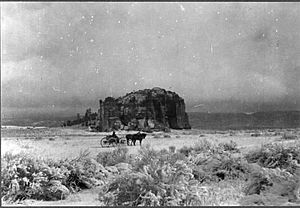Zuñi Mountains facts for kids
Quick facts for kids Zuñi Mountains |
|
|---|---|

Elk with Zuñi Mountains in background
|
|
| Highest point | |
| Peak | Mount Sedgwick (35°10′26″N 108°05′42″W / 35.174°N 108.095°W) |
| Elevation | 9,256 ft (2,821 m) |
| Dimensions | |
| Length | 60 mi (97 km) NW |
| Width | 40 mi (64 km) |
| Naming | |
| Native name | Error {{native name}}: an IETF language tag as parameter {{{1}}} is required (help) |
| Geography | |
| Country | United States |
| State | New Mexico |
| Geology | |
| Orogeny | Laramide |
The Zuñi Mountains are a group of mountains found mostly in Cibola County, in the northwest part of New Mexico, United States. A small part of the mountains also stretches into McKinley County.
These mountains are largely located within the Cibola National Forest. They lie south of Interstate 40, between the towns of Gallup and Grants. The Zuñi Mountains are about 60 miles (97 km) long and 40 miles (64 km) wide. The tallest peak is Mount Sedgwick, which stands at 9,256 feet (2,821 meters) high. The lowest parts of the range are around 6,400 feet (1,950 meters) above sea level.
Contents
Where are the Zuñi Mountains Located?
The Zuñi Mountains are found at 35°10′4″N 108°19′0″W / 35.16778°N 108.31667°W. They are surrounded by several important areas. To the southwest, you'll find the Zuni Indian Reservation, the Ramah Navajo Indian Reservation, and El Morro National Monument. To the south is El Malpais National Monument.
To the east lies Acoma Pueblo, and to the north is the Navajo Nation. The towns of Grants, Gallup, and Ramah are also nearby. The Zuñi Mountains are part of the Continental Divide. This means they help separate the rivers that flow to the Pacific Ocean from those that flow to the Atlantic Ocean. They also form part of the southeastern edge of the large Colorado Plateau.
A Look at Zuñi Mountains History
The Zuñi Mountains have a long and interesting history. Local native peoples, like the Zuni, Acoma, and Navajo, have used these mountains for a very long time. They continue to do so today.
In the early 1900s, there was a lot of logging (cutting down trees) in the mountains. Later, in the mid-1900s, people also used the land for agriculture (farming). There was also mining for materials like copper and fluorspar.
How the Zuñi Mountains Were Formed
The Zuñi Mountains are an "uplift," meaning they were pushed up from below the Earth's surface. The center of the mountains is made of very old rocks, called Precambrian granite and metamorphic rocks. These rocks are surrounded by younger layers of rock from the Late Permian, Triassic, and Jurassic periods.
Over time, about 20,000 feet (6,100 meters) of rock layers that used to cover the mountains have worn away. These older layers can still be seen in areas to the west and northeast. The ancient rocks in the Zuñi Mountains were first pushed up during a mountain-building event called the Ancestral Rocky Mountains orogeny. This happened during the Pennsylvanian Period. The mountains we see today were shaped by another major mountain-building event. This was the Laramide Orogeny, which happened about 80 to 40 million years ago.
See also
 In Spanish: Sierra de Zuñi para niños
In Spanish: Sierra de Zuñi para niños


